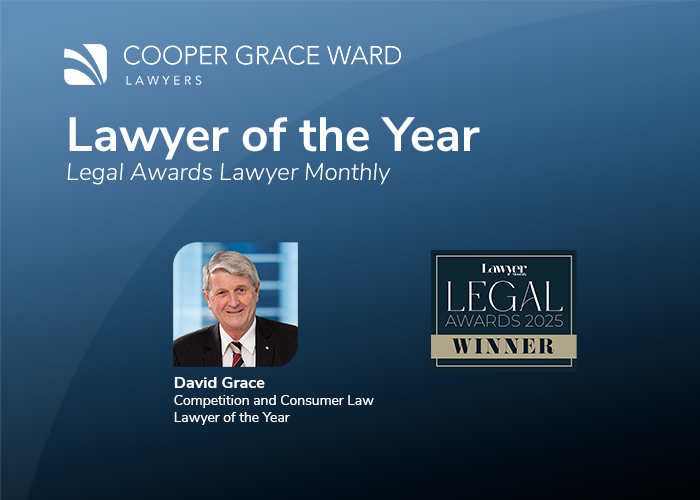Introduction
Since the amendment of the model defamation provisions in 2021, it has been a requirement for defamation claimants to prove that the publication they complain of has caused, or is likely to cause, serious harm to their reputation. The recent decision of the Queensland Supreme Court in Peros v Nationwide News Pty Ltd demonstrates that even the gravest of accusations can fail to meet this threshold of serious harm, representing a significant shift in defamation law in Queensland and other jurisdictions across Australia. The difficulties that can arise for plaintiffs in seeking to prove serious harm mean that separate hearings to determine the serious harm element will often be an effective strategy for defendants to employ at an early stage of a defamation proceeding.
‘Serious harm’ to reputation and the 2021 reforms
Before delving into the case of Peros v Nationwide News Pty Ltd (No 3) [2024] QSC 192 and its impacts on defamation law in Australia, it is beneficial to briefly set out some of the relevant context regarding the major reforms to defamation legislation enacted in 2021.
In 2021, the law of defamation in most Australian states and territories was significantly amended to provide that, in a defamation action, the claimant must prove that the relevant publication caused, or is likely to cause, ‘serious harm’ to their reputation. In Queensland, this new element is set out in section 10A of the Defamation Act 2005 (Qld). One of the main rationales behind introducing the ‘serious harm’ threshold was to discourage the bringing of claims where any compensation ultimately awarded would be dwarfed by the legal costs incurred by the parties.
Under the Act, a defendant to a defamation action may apply to have the ‘serious harm’ element determined in an early hearing prior to the full trial. Upon such an application being made, the court must determine the issue as soon as practicable, unless there are special circumstances justifying the postponement of the determination. The practical effect of this is that, in cases where the ‘serious harm’ element is not satisfied, the proceedings may be dismissed more quickly and cheaply as it is no longer necessary to hold a full trial of all the issues in dispute.
Our earlier article, ‘Defamation perspectives: separate ‘serious harm’ hearings and the Federal Court’ delved into some of the key differences between the approaches of the federal and state courts in relation to separate hearings on the question of serious harm. Unlike the Federal Court case discussed in our previous article,[1] in this case the Supreme Court of Queensland applied section 10A(4)-(5) the Act, and found that there were no special circumstances that justified postponing the determination of the serious harm question until the full trial.[2] The Court accordingly ordered that the serious harm element be determined at a separate hearing prior to the full trial. That hearing proceeded before Justice Applegarth.
Case facts
In 2014, the plaintiff, Mr John Peros, was charged with the murder of Ms Shandee Blackburn. In 2017, he was found not guilty of that charge by a jury. The Coroner subsequently began investigating the death of Ms Blackburn. On 21 August 2020, the Coroner published his findings of the cause of Ms Blackburn’s death. Those findings included that Ms Blackburn died due to injuries sustained in a violent act involving Mr Peros.
The Coroner’s findings were widely published by various newspapers and broadcasters. On 14 October 2021, the first defendant, Nationwide News Pty Ltd, and second defendant, journalist Hedley Thomas, began publishing Shandee’s Story, an investigative podcast into the death of Ms Blackburn.
That podcast compared the evidence before the jury in the murder trial with the evidence later made available to the Coroner to seek to explain how the jury and the Coroner came to different decisions. In doing so, the podcast highlighted the additional evidence available to the Coroner, as well as certain issues with the DNA evidence available to police during the course of their investigation into the murder of Ms Blackburn.
Mr Peros sued in respect of one particular episode of the podcast series, Episode 13. During Episode 13, the third defendant, Shannah Blackburn (the sister of Shandee Blackburn), was interviewed by Hedley Thomas. Mr Peros sued Shannah Blackburn for statements she made in that interview to the effect that she believed he killed Shandee Blackburn; these statements were then republished in Episode 13 of the podcast.
The defendants’ argument on serious harm
The defendants’ position was that Mr Peros had not suffered and was not likely to suffer serious harm to his reputation as a result of the publication of Episode 13 of the podcast. In short, the defendants argued the following:
- Before the publication of Episode 13, Mr Peros’ reputation had been severely damaged or destroyed by the findings of the Coroner and the widespread reporting of those findings in various outlets and in Episodes 1 to 12 of the podcast itself.
- As a result of these prior damaging publications, by the time of the publication of Episode 13 Mr Peros’ reputation was already that of the person who had been found by an independent Coroner to have violently killed Ms Blackburn.
- In those circumstances, Episode 13 did not cause, and is not likely to cause, serious harm to the reputation of Mr Peros.
Admissibility of other publications in relation to the ‘serious harm’ element
Before determining whether serious harm had been, or was likely to be, caused by Episode 13, the Court was required to resolve a dispute as to what evidence was admissible on the question of serious harm.
As mentioned above, the defendants sought to rely on the Coroner’s report, the various publications reporting on the Coroner’s findings, and Episodes 1 to 12 of the podcast itself as evidence that was relevant to the question of serious harm.
Mr Peros objected to this evidence on the basis of the ‘rule in Dingle‘.[3]
The rule in Dingle
The law of defamation allows defendants to reduce the damages that they are required to pay by proving that the plaintiff already had a poor reputation at the time of the publication. However, as Justice Applegarth explained, the rule in Dingle is an evidential rule limiting how a defendant can prove that the defendant had a bad reputation. The effect of the rule in Dingle is that, if the defendant wishes to prove the plaintiff had a bad reputation in order to reduce the plaintiff’s damages, they cannot do so by relying on publications by others to the same effect as the publication complained of. Rather, they must call witnesses who can give direct evidence of the plaintiff’s settled reputation.
In considering the question of the admissibility of prior publications, Justice Applegarth canvassed a number of English authorities and determined that there is a subtle distinction in those authorities between evidence relied upon as relevant to causation and evidence relied upon in reducing damages. His Honour found that the cases establish that the rule in Dingle does not prevent a defendant from relying on previous publications about the plaintiff in relation to the issue of causation. This means that the defendant can argue that the specific publication in question did not cause the claimed loss, perhaps because the plaintiff’s reputation was already damaged by an earlier publication or event.
Justice Applegarth further explained that with the introduction of the serious harm element, the presumption that a defamatory publication will necessarily damage the complainant’s reputation has been removed. A plaintiff must now prove that a defamatory publication has actually caused, or is likely to actually cause, serious harm; that is, the question of serious harm is a question of causation. His Honour concluded that to properly assess the causative effect of a publication on a plaintiff’s reputation, it is necessary to determine the state of the plaintiff’s reputation immediately before the publication date. This helps to isolate the harm caused by the publication complained of, distinguishing it from any harm caused by other publications.
Application of the rule in Dingle
In this case, Justice Applegarth found that the Coroner’s report and publications referring to it were not being relied on by the defendants to prove that Mr Peros had a bad reputation for the purposes of reducing damages, so as to be captured by the rule in Dingle. Rather, the defendants were seeking to rely on this evidence to prove that the element of causation of serious harm by Episode 13 was not established.
The Coroner’s report, the publications referring to it, and Episodes 1 to 12 of the podcast were admitted on the basis that they were relevant to determining the state of Mr Peros’ reputation immediately before the publication of Episode 13, and therefore to the question of whether Episode 13 had itself caused serious harm to Mr Peros’ reputation.
Justice Applegarth also found that the Coroner’s report would have in any event been admissible as an exception to the rule in Dingle, which allows judicial findings to be admitted as evidence to proving a plaintiff’s bad reputation. His Honour considered that the Coroner’s findings were akin to a finding in a civil court proceeding and should therefore fall within the exception to the rule in Dingle applicable to judicial findings.
Did Episode 13 cause serious harm to the plaintiff’s reputation?
Having reached the above conclusions on what evidence was admissible on the question of serious harm, Justice Applegarth then turned to consider whether Episode 13 had in fact caused, or was likely to cause, serious harm to Mr Peros’ reputation.
As previously mentioned, the introduction of the serious harm element removed the common law presumption that a defamatory publication causes damage to a plaintiff’s reputation. Therefore, it is now far more important for a plaintiff to be able to call witnesses who can speak to the actual impact that the defamatory publication had on their view of the plaintiff.
The plaintiff did not call any witnesses who could give direct evidence of the impact that Episode 13 had on their views in relation to Mr Peros’ role in Ms Blackburn’s death. Mr Peros’ argument was largely that an inference should be drawn that serious harm was caused to his reputation given the gravity of the imputations and the wide publication of Episode 13.
His Honour noted that while the gravity of the defamation is relevant to the question of serious harm, it is not determinative of the issue. Even the gravest of accusations will not cause serious harm to a reputation if the recipients of the publication did not believe it, or (relevant to this case) if the accusation did not have a substantial impact on their opinion because they already held a negative view of the person.
His Honour found that the majority of people who listened to Episode 13 would have also listened to Episodes 1 to 12 of the podcast, and that listeners to those episodes would have reached the view that Mr Peros was Ms Blackburn’s killer. Episode 13 merely repeated and reinforced that conclusion to the listener.
Accordingly, his Honour concluded that Episode 13 did not cause a significant change in the listeners’ belief regarding Mr Peros’ responsibility for Ms Blackburn’s death. Even if Episode 13 had some impact, his Honour concluded that further harm did not amount to serious harm for the purpose of section 10A of the Act. Mr Peros’ claim for defamation was therefore dismissed for failing to prove the serious harm element.
Comments
As Justice Applegarth acknowledged, it might seem a confronting conclusion that a podcast published to hundreds of thousands of listeners that essentially accused a person of murder could be considered not to have caused serious harm to that person’s reputation. However, as the judgment makes clear, the question of whether serious harm has been, or is likely to be caused, depends on all the circumstances.
Those circumstances will generally include the gravity of the defamatory imputation and the extent of publication. However, the relevant circumstances might also include:
- the identity of the publisher, as a defamatory publication by a credible source is more likely to cause serious harm
- the form of the publication, as statements made in an ephemeral medium (for example, social media comments that are later deleted) may have less potential for harm than a statement made in a more permanent form
- the identity of the recipients and how the publication would have impacted them (for instance, a publication to a plaintiff’s family might have no effect if the family immediately disbelieve it)
- as was decisive in the Peros case, the state of the plaintiff’s reputation immediately before the publication.
The Peros case demonstrates that, in the absence of strong evidence in relation to these factors, plaintiffs may find it very difficult to clear the hurdle of ‘serious harm’, even in the context of grave accusations. This decision also establishes that earlier publications regarding the plaintiff may be admissible as evidence relevant to the causation of serious harm to reputation. Accordingly, if there are multiple publications that each convey similar imputations, claimants and publishers will need to carefully consider the impact those earlier publications may have on the determination of serious harm.
The case also shows the potential advantages for defendants in seeking separate hearings on the question of serious harm in advance of a trial. In this case, in the event they were unsuccessful in arguing that Mr Peros did not suffer serious harm to his reputation, the defendants intended to defend the publications on the basis that they were substantially true. A trial on this basis could have essentially turned into a murder trial conducted on the civil standard of proof, and the defendants estimated that such a trial would have exceeded six weeks in length. As Justice Applegarth noted, preparing for such a trial would have required the parties to incur substantial financial and emotional costs. In contrast, the hearing on the question of serious harm lasted only two days and resulted in the complete dismissal of the proceeding.
In light of the Court’s interpretation and application of the application of the ‘serious harm’ element, it is clear that parties to defamation disputes must (to the extent possible) have a clear strategy to address this element before commencing proceedings . This is particularly so given the legislative intention was for this element to be determined in advance of a trial. The strategy behind the plaintiff’s concerns notice, pleadings and evidence will be critical to the question of serious harm, and failing to address these matters at an early stage can have dire consequences for litigants.
[1] Peros v Blackburn [2024] FCA 177, which involved the same plaintiff and a mostly similar factual background, except for the fact it was brought in the Federal Court as opposed to a State court.
[2] Peros v Nationwide News Pty Ltd (No 2) [2024] QSC 080.
[3] The rule bears its name from Associated Newspapers Ltd v Dingle [1964] AC 371







